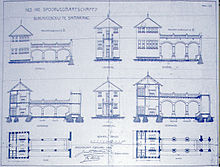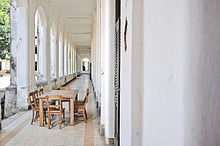
Jakarta Kota Station is a railway station, located in the old city core of Kota, Jakarta, Indonesia.

Gambir Station is a major railway station in Gambir, Gambir, Central Jakarta, Jakarta, Indonesia. The station is located on the eastern side of Merdeka Square and the western side of the Pramuka Movement headquarters and Immanuel Church. It is operated by the KAI.

The Ambarawa Railway Museum is a museum located in Ambarawa in Central Java, Indonesia. The museum preserves around 21 steam locomotives and focuses on tourism train tours hauled by 3 operational steam engines and a hydraulic diesel engine, using the remains of the closing of the 3 ft 6 in (1,067 mm) railway line.

Surabaya Pasar Turi Station or Surabaya Pasarturi Station (SBI) is the second largest railway station in Surabaya, East Java. It is located near the Pasar Turi market in Bubutan, Surabaya. It is the main departure point of all train from Surabaya which passes through Pantura to the western cities of Java such as Jakarta and Semarang, but trains south and east line from Surabaya departed from Surabaya Gubeng. Since 2014, the station has upgraded railway signal and railroad switch devices from mechanical to electrical type produced by Len Industri.
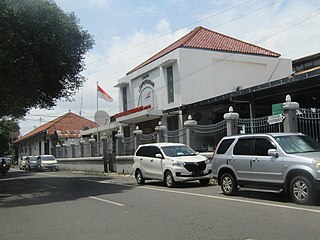
Lempuyangan Station is a railway station located in Bausasran, Danurejan, Yogyakarta, Indonesia. It is 1 kilometre (0.62 mi) east of Yogyakarta Station, 114 metres (374 ft) above sea level. The station is part of Operational Area VI Yogyakarta. It has 11 lines, including two straight tracks.
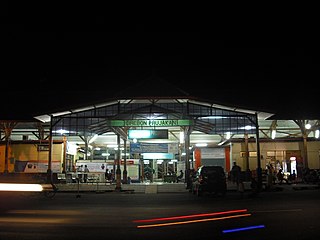
Cirebon Prujakan Station (CNP) is a railway station in Cirebon, West Java, Indonesia. The station is located at a height of 4 metres above sea level. It is located at Nyimas Gandasari Street, Pekalangan, Pekalipan, Cirebon. Cirebon Prujakan Station is the largest station on DAOP 3 Cirebon after Cirebon Station and Jatibarang Station.

Lawang Sewu: Dendam Kuntilanak is a 2007 Indonesian Horror film directed by Arie Azis. The film tells about a group of seven teenagers from Jakarta is in Semarang to celebrate their high school graduation. Along the road home after partying, they stopped by Lawang Sewu, a supposedly haunted building in Semarang, to relieve themselves. One of the girls went inside the building to avoid the boys and didn't come back. When they start to find their missing friend, the night turns into a nightmare for other six, who find themselves haunted and terrorized by a Kuntilanak.
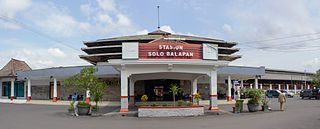
Solo Balapan Station is a major railway station in Surakarta, Central Java, Indonesia. The name "Balapan" is taken from the name of a village which is located to the north of the station. The station is located on the railway line that connects the cities of Bandung, Jakarta, Surabaya, and Semarang. Solo Balapan Station is the largest station in Surakarta and Central Java.

Depok Station (DP) is a railway station located in Pancoran Mas, Pancoran Mas, Depok, West Java. This station is commonly known as Depok Lama, to distinguish with Depok Baru Station. The station is one of the oldest station in Jakarta metropolitan area. At present it serves as a station of Jakarta Commuter Rail. Depok EMU depot is located to the southwest of the station.
Most railway lines in Indonesia were constructed during the Dutch colonial rule. After independence in 1945, many lines were abandoned. The current national rail operator, PT Kereta Api Indonesia (Persero), was founded on 28 September 1945.

Semarang Poncol Station (SMC) is a historic railway station in Purwosari, North Semarang, Semarang, Indonesia. The station which is located at an altitude of +3 meters is included in the Semarang Operational Area IV and is the second main station in Semarang after Semarang Tawang Station. It was built in 1914 and is considered an early example of Art Deco architecture.

N.V. Nederlandsch-Indische Spoorweg Maatschappij, abbreviated to NIS, NISM or N.V. NISM was a private-owned railways company in charge of rail transport in Java, Dutch East Indies. The company's headquarters were in Semarang, Central Java. The company started its maiden route from Semarang to the Vorstenlanden and in 1873 they also built their line to the Willem I Railway Station of Ambarawa–Kedungjati and Batavia–Buitenzorg lines. Later the network expanded to Bandung and Surabaya. It was absorbed into the present Kereta Api Indonesia after Indonesian independence in 1949. It was the main competitor to Staatsspoorwegen as state-owned railway company and established on April 6, 1875.

Sawah Besar Station is a railway station, located on Jl. Kyai Haji Samanhudi. Altitude this station is 15 meters amsl, this station is one of seven elevated stations on Jakarta railway's Jakarta Kota–Manggarai segment, and is named after the Jakarta subdistrict with the same name. Pasar Baru market is within walking distance from this station.

Brambanan Station (BBN) also known as Prambanan Station, is a class I railway station located in Kebondalem Kidul, Prambanan, Klaten Regency, Central Java, Indonesia; about 750 meter from Prambanan Temple complex. The station, which is the westernmost railway station in the regency, is at an altitude of +146 meters and operated by Operational Area VI Yogyakarta of Kereta Api Indonesia (KAI). The station road connects this station with the Solo-Yogyakarta highway.

Staatsspoorwegen was a state-owned railway company managed by the Dutch East Indies colonial government. It was absorbed into the present Kereta Api Indonesia after Indonesian independence in 1945. The main competitor was Nederlandsch-Indische Spoorweg Maatschappij (NIS) as private-owned railways company which had standard gauge and cape gauge lines.

Cikampek Station (CKP) is a large class type B railway station located in Cikampek Kota, Cikampek, Karawang Regency. The station, which is located at an altitude of +46 meters, is the station that is located in the easternmost part of the Operational Area I Jakarta and Karawang Regency, and is the largest railway station in Karawang Regency.
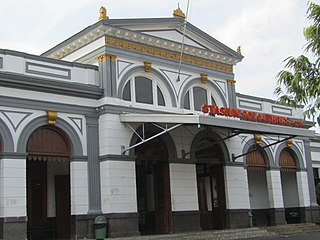
Solo Jebres Station, also known as Jebres Station, is a type-C large class railway station in Surakarta, Central Java, Indonesia. The station, which is located 97 metres (318 ft) above sea level, is operated by Operational Area VI Yogyakarta of Kereta Api Indonesia (KAI). It is one of the major railway stations in the city.

Kedungjati Station (KEJ) is a class III railway station located in Kedungjati District, Grobogan Regency, Central Java, Indonesia. The station is located at an altitude of +36 meters and is operated by Operation Area IV Semarang. The station once had a junction to Ambarawa Station until it was closed in 1976.

Tuntang Station (TTG) is a class III railway station located in Tuntang District, Semarang Regency, Central Java, Indonesia. The station is located at an altitude of +464 meters and is operated by Operation Area IV Semarang. The station only serves excursion trains from the Ambarawa Railway Museum


